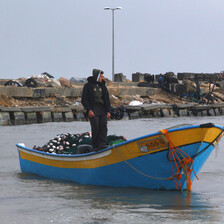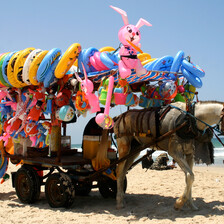The Electronic Intifada Gaza City 10 August 2011

The seashore is a place for Gaza families to relax, if they can afford to get there.
MaanImagesGAZA CITY (IPS) - On any given evening, Gaza’s small downtown pedestrian area, the Jundi, is crowded. Many people are fleeing the heat of their homes during the regular power cuts. Most are there for want of something to do, even if that means merely sitting on the park’s simple concrete benches to talk and sip tea.
Snack vendors sell roasted nuts and seeds, and tea and coffee sellers circulate with flasks of sweet mint tea and strong Arabic coffee. In recent years, mimicking New York City’s Central Park, three horses with old-fashioned style carriages also trot around the park.
The organizers of the carriage rides say their idea came from the old days.
“Four years ago, my father saw a horse and carriage in an old film and it reminded him of Palestine in the past when horses and carriages were common,” says Ramadan Al, a 21-year-old blacksmith.
Al and his 13 siblings became jobless when Israel imposed its extensive siege on the Gaza Strip in 2006. The family needed a new source of income.
“We used to make doors, windows, whatever people wanted, but after the borders closed, steel stopped coming into Gaza, and we couldn’t do much with the steel we had because of the constant power cuts,” Al says.
“Since we already had horses and knew how to work with metal, we decided to design a leisure carriage.”
The project was an immediate success. “We had a lot of work right away, because it was a novelty. People started asking us to deliver couples to their wedding halls.”
But now, a few years later, work is not as steady. “The novelty has worn off a little,” Al admits. On an average evening, ten families ride the carriages; on a weekend, half as many more.
“The problem is that people who have money are saving it for gifts and donations during the month of Ramadan and for the new school year,” says Al.
“We charge five shekels to circle around the park, but when I see families who don’t have the money but whose children want to ride, we take them without fare, so the kids can enjoy themselves a little.”
Al says he preferred working as a blacksmith but was left with no choice under the Israeli siege than to find a new source of income. “As difficult as the siege is and our lives in Gaza have become, we always find a means to continue living, despite the worst conditions.”
Train offers respite from reality
With a similar desire to create something novel, Gaza engineers created their version of a children’s train.
Made largely from scraps and spare car parts, the red and white, two-car one-engine train cruises from the Jundi along Gaza’s main streets playing music and giving children a ride for just two shekels. Idyllic scenes of green pastures dress the passenger cars as Gaza’s children escape the bleak reality of grey cement, bombed buildings and bulldozed farmland.
Gaza City’s municipal park offers little other than dehydrated greenery and a different place to while away the hot afternoon hours. The fountain is waterless, the plants stunted. The children’s play area has a number of short plastic slides and a swing-less swing.
With a dearth of leisure options to choose from, families still visit the park, friends take breaks together and children hunt for a place to play.
Beach is free but excursions cost
In summer, Gaza’s coast is the most congested leisure venue, families seeking cool and change. Most families come equipped with flasks of tea and picnic spreads. Children swim, fly kites and play football, women wade and cool off in the low waves and young men sit together with tea and tobacco water pipes.
Yet while the sea itself doesn’t cost anything, getting there does and not everyone can afford the excursion. Jaber Rjila, from a repeatedly bulldozed farming area in southeastern Gaza, is among those who rarely go to the beach, even though it is just a half hour ride from his home.
“To take my six kids and my wife, it’d cost nearly 200 shekels just for transportation and a simple picnic,” he says. “We can’t afford that, so we just try to enjoy ourselves on our land here. Our kids might have a school trip once a year to the sea or a park and for half a day they get to play. But that’s not enough, it’s not like elsewhere where there is safety, where there is work and children have places like amusement parks.”
Slightly south of the Gaza harbor, the women and children of a family from Beach refugee camp not far away bask in the sea’s cooling water. Children, having learned about buoyancy, stuff their shorts and t-shirts with washed up pieces of styrofoam. Simplicity at its best, the sea is the main leisure option in a Strip devoid of movie theatres and where the few existing playgrounds are run down.
For those with the shekels to spare at the beach, Fadel Bakr’s small motorboat offers short coast-hugging jaunts on the sea.
“I started this seven years ago. But these days not as many people take rides: either they don’t have money or they are afraid of the Israeli navy’s shooting,” says Bakr.
A 10-minute boat ride costs 20 shekels.
“We used to go much further out into the water, a real sea ride, but now we generally go just a few hundred meters. Even so the Israelis have shot at my boat with passengers in it.”
Some are still willing to risk it, keen for a change and some leisure activity in their lives encaged and under siege.
All rights reserved, IPS - Inter Press Service (2011). Total or partial publication, retransmission or sale forbidden.





